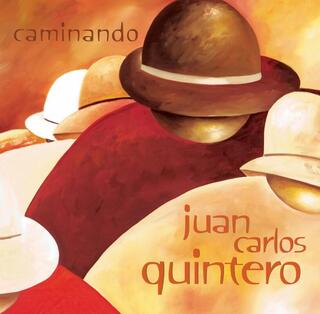
In addition to those two, Caminando features percussionists Munyungo Jackson, Walter Rodriguez, Tiki Pasillas, Angel Figueroa, and Ron Powell. Eddie Resto and Alec Milstein are both featured on bass while Joe Rotondi sits the piano. Together this group provides the ideal backdrop and support for Quintero’s vibrant guitar.
Quintero and his family left Medellin, Colombia when Juan Carlos was just a baby. Still, the rhythm and reason of Colombia’s intoxicating music legacy never left him. At the age of eight, he picked up the guitar. Juan Carlos says, “No matter what style I ever played in, I always came back to my heritage. Music from Colombia crosses so many boundaries and its ability to seduce while celebrating life has always moved me. Colombian rhythms are so majestic, they have a strong natural appeal to me. This music seems to show up every time I compose or perform, I can't help it.”
All of that is made manifest from the very first track, El Baile (The Dance). He follows the cumbia folk style of Colombia. Quintero’s guitar style is at the same time precise and lush. The understated piano of Rotondi sets off flawlessly against the guitar. The percussion is subdued but magnificently frames the melodies.
Caminando (Walking) is such a cool take on the cha-cha-cha with it andante tempo, casting vivid imagery of a take-it-all-in afternoon stroll. It calls to mind Smetana’s tone poem The Moldau with its boat ride down the Moldau River. In the same way, Quintero creates image-after-image in this cha-cha-cha tone poem. Brilliant.
El Pueblo (The People) returns to the cumbia style and Quintero’s musical mastery is rarely more evident with his gorgeous tones and rhythmic delivery. Hermanos (Brothers) has a fascinating way of integrating the Latin with the American. The rhythms are unmistakably Latin while the melody ebbs and flows between the two. This is an intriguing composition that I like very much but then I am wild about the whole album.
Libre (Free) is sensationally driven by the bass lines beneath Quintero’s guitar and Rotondi’s subtle piano. It is a lovely melody that is indeed free. There is a joy and a warmth of the piece that is unmistakable. Pay attention to the interplay of guitar and piano. Gorgeous.
The Way Home is Quintero’s most emotional, even romantic. And if you think you’re hearing a touch of the bolero, you are correct. The touch of the Wes Montgomeryesque electric guitar is a sweet touch. Spring is as lovely as the William Blake poem of the same name. Both are wrapped in natural wonder. Quintero wrote the tune for his niece and he says of the piece, it is “a nursery rhyme run amok.” Lucky niece.
Caribbean Sun Dance is exactly what you would imagine—full of island rhythms and bright textures. The basses and percussion light it up and the piano is wondrously textured and nimble. Then come the final two pieces wherein Quintero and the band leave it all in the studio. Little Indians is a smoking hot, straight-ahead Latin Jazz number that leaves nothing to be desired. This thing just cooks.
Quintero wraps it all up nicely with Porque Si! (Because!) which tells you exactly why he ends it this way. It is a cool Cuban jam, like the descarga. The percussion is well worth the attention but Quintero himself turns it all loose to close out the album. With bent notes and quick-picks, this leaves you craving the days of records when you could turn over the album for more. Alas, nothing to turn over.
With the re-release of Caminando, Juan Carlos Quintero has returned us to the glory days when Jazz and Latin Jazz were not so distant. The artistry of Quintero and everyone involved is sterling and the compositions are soulful and touching. This is an album to savor over and over.
~Travis Rogers, Jr. is The Jazz Owl
 RSS Feed
RSS Feed
